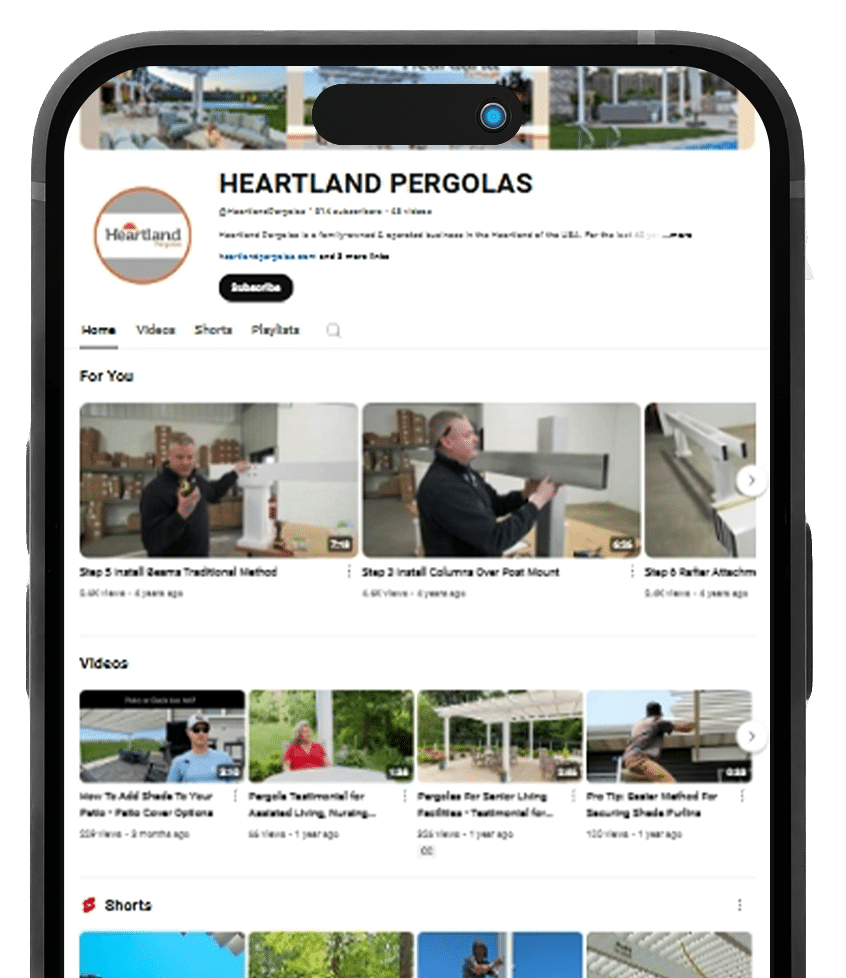Weather Resistant Pergolas | Will your pergola stand up to Mother Nature?
You’ve installed your beautiful patio pergola, enjoyed the first season of its shade, and entertained in your new backyard oasis but now the seasons are changing. Should you worry about the integrity and durability of your pergola structure as the seasons change? Is your pergola wind resistant? Will your pergola last through the winter?
![]()
Will My Pergola hold up in the winter?
Unless you are living in the Southern part of the US, you know that winter means snow, ice and at times extreme cold. The question on whether your pergola will hold up during the winter boils down to what your pergola is made of! If you purchase a wood pergola, the length of time your pergola lasts will greatly be dependent on the care you have given it. Proper staining each year can extend the life your pergola to 10-12 years. If you are not staining your pergola each season however, rot and mold is going to start affecting your pergola within 4-6 years typically. Once the structure is weakened by rot, survival through each winter is going to be numbered.
Metal pergolas, such as those found in big box stores like Lowe’s or Home Depot are often made of thin, cheap metal with poor construction on welds and components. These kinds of metal pergolas are very susceptible to rust or water getting in through unsealed areas. In the winter, water that has gotten inside the pergola can freeze, expand and with the lightweight construction of these types of pergolas cause breaks in welds or other connection points, weaking the entire structure.
With a vinyl pergola, specifically vinyl and aluminum pergolas, an engineered aluminum frame wrapped in strong durable vinyl is going to give you better longevity overall as the extruded aluminum frame is extremely strong and won’t rust. While the outer vinyl is impervious to the elements, these structures can last a lifetime with minimal effort!
Another consideration on winter durability is the roof structure. Pergolas that feature a solid roof or use shade structures can experience problems under the weight from large snow or ice storms. It’s possible these types of pergolas can collapse or tear when the snowpack gets too heavy.
An open louvred top designed pergola ensures that snow and ice are less likely to accumulate not adding the extra weight to your pergola versus those with a solid roof structure or solid shade screen.
Winter Care Tips
With a wood pergola your best care comes in the form of yearly maintenance, ensuring to properly stain to ward off rotting. If you use a sunshade across the top of your pergola, consider removing it during the winter to prevent snow accumulations that could tear or damage the shade.
With a metal pergola, check the welds and any hardware points on the structure for signs of rust or damage. While there isn’t much for maintenance during the winter months, you will want to look over the structural integrity, sand out and paint over any rust points and tighten any screws or hardware points that have come loose.
![]()
Vinyl pergolas are the easiest to care for all year round and winter is no different. The best winter tip for the longevity and care of a vinyl pergola is to be careful when shoveling around your pergola columns. If your pergola columns extend down to your deck or patio rather than a landscape paver top, you will want to be sure you use a plastic tipped shovel rather than a metal tipped shovel. Removing snow with a metal shovel could result in accidentally striking your pergola column which could chip or crack the vinyl.
Using salt to melt snow around your patio shouldn’t hurt your pergola posts either. However, it would be best to use a color-less calcium chloride to prevent any chance of staining should the salt sit at the base of your pergola column for an extended period of time.
What about the Wind? | Wind Resistance and your Pergola
Do you live in windy location or see strong storms blow through your area a couple times of year? You may wonder if installing a pergola is a worthy investment that can withstand mother nature. It’s all about the construction.
Pergolas and pergola kits come in all kinds of materials and quality. The ability to hang on through a strong windstorm or hurricane depends on several factors.
Let’s first talk about the materials. Anyone could run down to Lowes and pick up a lightweight metal or wood freestanding pergola. Often people throw these on their deck or patio themselves, without even doing the most basic of anchoring down. These pergolas are made of lightweight materials and will quickly become your neighbor’s new lawn ornament in a strong thunderstorm.
Following the instructions to properly anchor your pergola to the intended surface results in a big difference in how it holds up to wind and storms. Proper installation is key. Make sure you or your contractor don’t skip steps in the installation and use the proper tools and materials necessary.
The roof top of your pergola makes a difference here as well. Pergola sunshades or a solid top pergola gives the wind something to push against. That pergola sunshade instantly becomes a sail that either tears under the force of the wind or takes off with your whole pergola. The solid top pergola is going to be fighting against the wind and can result in the roof coming off your posts or being destroyed by pulling out your entire pergola!
A pergola that has an open top or louvred purlins allows the wind to blow around and through the pergola, decreasing the resistance and force against your structure. This type of design is going to fare much better against storm winds than a pergola with a solid top.
Check the Specifications and Product Warranty
Devil is in the details and here is where you need to do your homework. Read through the pergola’s warranty, is damage from wind included in the warranty? Are there extra accessories available to reinforce your pergola? We can look at Heartland Pergolas as an example of what to look for.
Heartland Pergolas aluminum and vinyl pergolas all come with a limited lifetime warranty on materials. They also offer ‘Hurricane Clips” which is a simple clip added to each beam and column attachment point. The Hurricane Clips help add an extra level of reinforcement. In engineering tests, Heartland Pergolas that were properly anchored into a wood deck are rated for winds up to 115 mph, while pergolas properly anchored in via concrete are rated for winds up to 150mph! So, a properly installed Heartland Pergola can withstand a category 3 or 4 hurricane! That should give you a little breathing room when it comes worrying about the longevity of your pergola.
Mother nature is a force to be reckoned with but choosing the right materials for strength, stability, and ease of maintenance means you will get to enjoy your pergola for many years to come.
To review more details about a Heartland Pergola warranty or options needed to keep your pergola safe, check out the FAQ section!


